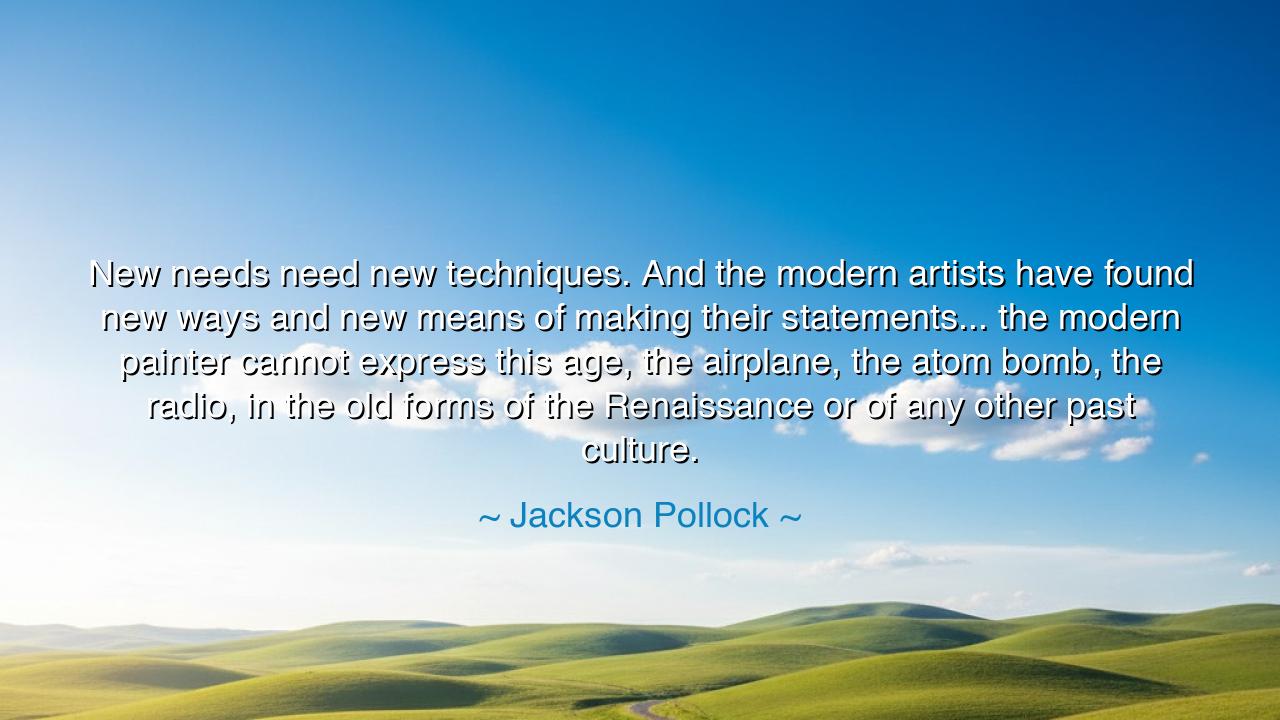
New needs need new techniques. And the modern artists have found
New needs need new techniques. And the modern artists have found new ways and new means of making their statements... the modern painter cannot express this age, the airplane, the atom bomb, the radio, in the old forms of the Renaissance or of any other past culture.






"New needs need new techniques. And the modern artists have found new ways and new means of making their statements... the modern painter cannot express this age, the airplane, the atom bomb, the radio, in the old forms of the Renaissance or of any other past culture." — Jackson Pollock
In this profound reflection, Jackson Pollock speaks to the evolution of art and the necessity for new techniques to address the new needs of a rapidly changing world. Gone are the days when the brushstrokes of the Renaissance were sufficient to capture the complexities of human experience. The world has been reshaped by forces that were unimaginable to past generations: the airplane, the atom bomb, and the radio have altered the very fabric of reality. These forces demand new methods, new expressions—new artistic languages. To capture the essence of this modern age, the artist must not cling to the tools and forms of the past, but must forge ahead, using innovation to give voice to the present.
Pollock’s words are a call to arms for the artist, urging them to embrace change rather than resist it. The world of the past, with its well-established forms and structures, cannot speak to the alienation, the technological revolution, and the dizzying pace of modern life. The traditional means of expression—whether in the classical forms of painting, sculpture, or music—have been shaped by the values and concerns of earlier generations. These techniques, though brilliant in their time, are now inadequate for conveying the full weight of contemporary life. The artist, if they are to remain relevant, must create new tools and methods that reflect the concerns of today.
Consider the example of Giorgio de Chirico, an Italian artist whose early work shocked the world with its surreal landscapes and dreamlike qualities. In the wake of the horrors of World War I, de Chirico felt that traditional art could not capture the dread and disorientation brought on by the war. His use of mysterious forms, empty spaces, and dislocated objects created a visual language that spoke to the unease of the time. Just as de Chirico broke from tradition to capture the chaos of the early 20th century, Pollock’s own abstract expressionism broke with tradition to address the equally tumultuous age of atomic power, global conflict, and psychological upheaval.
Pollock’s art itself was a manifestation of his philosophy. His iconic drip paintings did not just emerge from a desire to be new for newness's sake, but from a deep engagement with the chaotic forces of the modern world. His method of painting—letting the paint fall, drip, and splash across the canvas—was an expression of the disordered nature of existence. Just as the airplane defied the natural limits of space, and the atomic bomb shattered the boundaries of life itself, Pollock’s paintings reflected the freedom and instability of modern life, rejecting the static and the controlled in favor of the wild and the spontaneous. His work became a language of the age—raw, unstructured, and visceral.
This lesson is not just for artists but for all of humanity. New needs require new solutions, whether in art, science, politics, or daily life. As the world changes, so must we. The methods and philosophies of the past are not inherently outdated, but they are no longer sufficient for dealing with the unique challenges of the present. The failure to adapt—to develop new techniques, new ideas, and new ways of thinking—leads to stagnation. Just as the modern painter must find new ways to express the realities of their time, so must each of us find new ways to navigate our world, to engage with its complexities and to solve its problems.
Pollock’s challenge is one of innovation and adaptation. He calls on us to cast aside the comfort of tradition when it no longer serves our needs. We must have the courage to break with the past, to experiment, and to risk failure. But it is only through this boldness that we can create a future that is both meaningful and relevant. Whether we are artists, leaders, or ordinary individuals, we must be willing to let go of outdated methods and find new tools for the challenges we face.
In the end, Pollock’s wisdom teaches us that the past is a wellspring of inspiration, but it is the present that demands our attention. By embracing the new, we not only adapt to the changes around us but shape the world that is to come. Let us honor the traditions that have shaped us, but also recognize that the future belongs to those who have the courage to forge new paths and create anew. The journey of life is one of constant transformation, and those who master the art of reinvention are the ones who will leave their mark on the world.






AAdministratorAdministrator
Welcome, honored guests. Please leave a comment, we will respond soon